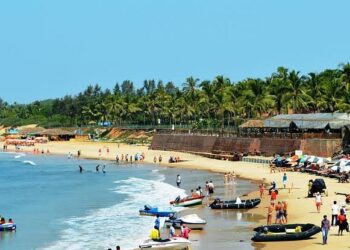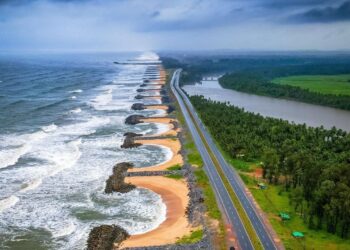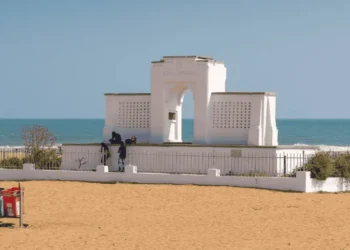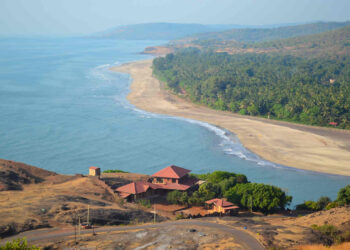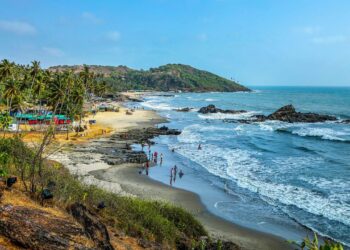The Gokarna Mahabaleshwar Temple, located in Gokarna, Karnataka is a sacred haven for Lord Shiva, worshipped as Mahabaleshwar, meaning “great strength.” It’s 450 km from Bengaluru and 140 km from Mangaluru nestled by the Arabian Sea, this ancient temple, known since at least the 4th century, is one of India’s seven Mukti Sthalas, or liberation sites. Covering around 2 acres, the temple is built in Dravidian style.
Legend of the Temple
The Gokarna Mahabaleshwar Temple holds stories that feel close. A key tale from the Shiva Purana tells of Ravana, the demon king, who wanted Shiva’s mighty Atmalinga to make Lanka unbeatable. Shiva gave it to him but said it must never touch the ground. The gods, worried about Ravana’s plans, tricked him. At Gokarna, he gave the linga to a boy—Lord Ganesha in disguise—who set it down, fixing it to the earth. Ravana tried to lift it but failed, naming it Mahabaleshwar for its strength. People believe touching it frees the soul, as Shiva’s power stays here.
Another story links Gokarna to sage Agastya, who prayed here, calling the land “cow’s ear” (Go-karna) for its shape. These tales make the temple feel holy, like Shiva’s spirit guards the coast.
History of the Gokarna Mahabaleshwar Temple
The temple’s roots go back to at least the 4th century, mentioned in the Skanda Purana. Stone writings from the 14th century, during the Vijayanagara era, show its importance, with King Bukka Raya giving land for its upkeep. Old records hint at worship even earlier, tied to coastal Shaiva ways. The temple we see was rebuilt in the 16th century by Vijayanagara kings, showing Dravidian style.
By the 10th century, the temple was a lively place, with fishermen, traders, and priests keeping it strong, Kannada papers say. The Keladi Nayakas, in the 17th century, built walls around Gokarna, and the Marathas, in the 18th century, helped maintain it. The Portuguese caused some trouble nearby, but the temple stood firm. The British took over in the 1800s, and now Karnataka’s HR&CE Board runs it, with the Ramanathaswamy Trust helping out.
The temple’s past lives in Kannada works, like Pampa’s Adi Purana, and its role as a holy spot for Konkani and Kannada people. Its history, from old times to today, ties it to coastal temples like Murudeshwar, showing Karnataka’s deep Shiva faith.
Architecture of the Temple
The Gokarna Mahabaleshwar Temple is Dravidian style, covering 2 acres. Its gopuram, not too tall, has carvings of Shiva’s dance and sea creatures, painted soft white. The sanctum holds the Atmalinga, a 3-foot black stone linga, half-hidden in a pit, touched only by priests. Devotees feel a smaller linga, believed to link to the main one. A Ganesha shrine nearby recalls his trick on Ravana.
The sabha mantapa, with 20 stone pillars, has carvings of the Shiva Purana and fish, showing Gokarna’s sea life. A holy tank, Kotitheertha, 200 meters away, is for ritual dips. The temple’s outer walls have Vijayanagara-era Kannada writings about gifts from kings. A 10-foot Nandi statue, made in the 17th century, sits at the entrance. The beach nearby, with waves rolling in, fits with the Tamra Gauri Temple close by, rooting the site in Karnataka’s old coastal world.
Festivals and Rituals
The temple shines during festivals, especially Maha Shivaratri in February or March, when thousands come for prayers all night and pour milk and honey on the linga. Kartika Purnima in November lights up the linga with lamps, joined by bhajans. Gokarna Utsava in January brings Yakshagana dances, pulling in coastal folks. Daily rituals, from 6 AM to 1 PM and 4 PM to 8 PM (free to enter, ₹100 for quick darshan), offer bilva leaves and coconuts, with the Mahabaleshwar mantra ringing out.
Festivals keep Karnataka’s ways alive. Carnatic music, with flutes and drums, and Kolata dances telling Shiva’s stories, the temple’s place in Shiva worship and its link to Gokarna’s past, like Om and Kudle beaches, make it a spiritual center.
It’s easy to reach by auto-rickshaw from Gokarna or bus from Karwar (55 km). It’s part of a holy trail with Murudeshwar (80 km) and Udupi (180 km). Mangaluru Airport is 150 km away. Open daily, it’s best from October to March when it’s cool. Many visit Idagunji’s Ganesha Temple (70 km). The temple welcomes all, no matter their faith, and its story, from ancient days to Vijayanagara help, joins Karnataka’s past to now.
Conclusion
The Gokarna Mahabaleshwar Temple is a precious piece of Karnataka’s past calling those seeking Shiva’s blessings and grace, many from India and far away, where his divine presence still fills up in the surroundings of the temple making is a must visit temple in Karnataka state.

